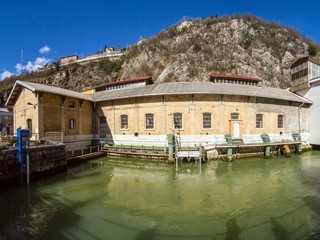The pumping station
address: Vodovodna StreetPeriod: Secession/Art Noveau
Kind: Immovable material heritage
Century: 19
Year: 1894
Purpose: the pumping station
The building of the pumping station was erected in 1894. It consists of only four rooms arranged according to an L-shaped ground plan. The walls are covered with colourful bricks of a lighter tone, and the windows were additionally emphasized with fan-shaped brick lintels. Besides the pilaster strips which were used to achieve a simple decoration of the walls, perhaps the most interesting detail is a wrought iron Art Nouveau floral console under the roof. Stylistically speaking, it can be assumed that this building significantly influenced the construction of the thermal power plant complex, which was built later, in 1906.
After the construction of the Waste Incineration Plant, the Zvir pumping station, just like the nearby Slaughterhouse, used its thermal energy to run a steam engine, which in turn drove an electric generator with a rated power of 150 kVA. The energy produced was used to power the electric motors in the pumping station.
The Zvir spring was used in the previous period for water supply of Rijeka and Sušak. At first, Sušak used a spring near the Paper Mill in the former Tvornička Street. The water was pumped into the water tank on Louisiana Road for the low supply zone (Sušak with Brajdica and Pećine) and Trsat’s water tank for the high supply zone (Trsat and Boulevard). Problems arose after the outbreak of typhus in Sušak, its cause being a contaminated source of drinking water. The people of Sušak were forced to buy water from the Zvir spring using Rijeka’s aqueduct which was built in the 1890s. Reportedly, the costs of buying water were extremely high and that was, to some extent, regulated with the agreement from 1908, after which they received the right to purchase water for 9 fillér per m³. In 1913/14, the problem of Sušak’s water supply was finally solved with the construction of a new water conduit, a water main that brought drinking water from the 18 km distant Rječina spring to Sušak.
Valorization:The pumping station was preserved in its original form. The old pumps have also been preserved, but are no longer in function today. An annex was built on the existing old building which is an entirely modern, glass construction, covering the well and containing new water pumps.
Bibliography:
L'Azienda Servizi Publici Municipalizzati di Fiume nel suo Trentennio: 1909-1939/XVII., Rijeka 1939.
Čabrijan, Boris, Rječina i njezini mostovi, Sušačka revija 5, godina 1, Klub Sušačana, Rijeka, 1993.
Rački, Andrija, Povijest grada Sušaka, Tisak Primorskog štamparskog zavoda d.d., Sušak, 1929.




